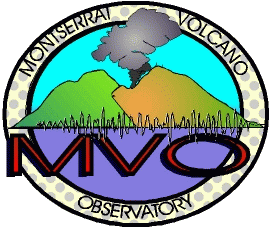

The Montserrat Volcano Observatory was established shortly after the first phreatic eruption of the Soufriere Hills Volcano on July 18th 1995. The Observatory is staffed by scientists from a variety of organisations working with local personnel. The scientific teams come mainly from the Seismic Research Unit (SRU) of the University of the West Indies in Trinidad and the British Geological Survey (BGS).
The role of the MVO is to advise the civilian authorities on the volcanic activity and its associated hazards. Funding of the Observatory comes from the U.K. Overseas Development Administration and the Government of Montserrat.
SRU has responsibility for volcanic and earthquake monitoring in the English-speaking Eastern Caribbean countries. In Montserrat, they have been assisted by the British Geological Survey, the United States Geological Survey, the University of Puerto Rico and several individual researchers from universities in the U.S. and the U.K.
The Observatory is based in temporary accommodation in Olde Towne, northwest of the volcano. This is in the safe zone, so that continuous monitoring can occur even during an evacuation. A permanent observatory is planned.
There are a number of strands in the research carried out by MVO, to try to monitor all aspects of the volcanic activity.
Earthquake Monitoring
Two seismic networks are in operation at the moment. The short-period network has been in place since July 1995, and includes stations that were operated by SRU before the crisis started. The signals from 8 short-period stations are transmitted to the Observatory by radio links and phone lines. The stations are located around the volcano and detect the ground movements caused by local earthquakes and dome collapses. Occasionally, large earthquakes outside Montserrat are also recorded. The seismic signals are monitored 24 hours a day at the Observatory. Four of the stations are written on paper drum recorders to give a real-time view of the seismic activity. All the signals are digitised and processed on a computer system, which enables the scientists to calculate the location of local earthquakes.
A new seismic network was installed in October 1996. This consists of five broadband, three-component sensors and three short-period, one-component sensors. The broadband sensors are capable of recording the seismic vibrations in much greater detail than the existing network, and will eventually enable a better understanding of volcanic processes. The two seismic networks will operate in parallel for at least a few months.
Deformation Monitoring
Measurements between fixed points on the flanks of the volcano are made daily using a "Total Station", which measures distances using an Electronic Distance Meter (EDM). This technique uses an infra-red laser beam to make very accurate measurements between two points. Two reflectors are positioned high on the flanks of the volcano and reflect the infra-red beam back to the instrument which is installed at a fixed point lower down. Daily changes to these measurements are caused by deformation of the volcano, and may indicate the movement of magma.
The Global Positioning System (GPS) is also used to detect deformation. GPS receivers record signals from orbiting satellites and these signals are processed to calculate the average distance between the receivers, with an accuracy of less than 1 cm. Repeated measurements between the same sites can show if deformation is ocurring.
There are two different GPS programs in operation. Temporary GPS sites are occupied every week on sites around the island. There are several different networks, around the volcano and one that includes points in the north of Montserrat. There are also two permanent sites, where recievers record GPS signals for 20 hours each day. These are operated by the University of Puerto Rico.
The GPS stations are located further from the volcano than the EDM points, and thus can detect deformation over a wider area; such deformation may be due to a deeper source.
Other observations
The scientific team makes visual observations from the ground and from helicopter flights over the volcano. Flights to view the crater area are made whenever visibility is good. Occasional trips are made on foot to Chances Peak, on the west side of the crater rim, when it is safe enough to do so.
Measurements of the topography of the growing dome and the pyroclastic flow deposits are made regularly. Several different techniques are used, including surveys with laser range-finding binoculars from the ground and the helicopter, and measurements from photographs taken at fixed points. The aim of these studies is to quantify the dome volume and rate of growth.
Gas samples are collected from the hot springs (soufrieres) and these are analysed for the content of various gases. SO2 production from the volcano is monitored using a Correlation Spectrometer (COSPEC), which is driven along the coast road round the south of the island, beneath the gas plume. These measurements enable an estimate of the SO2 flux to be estimated in tonnes per day. SO2 monitors have also been placed at various locations around Plymouth to measure the amount of gas that is drifting from the crater area. Rainwater and ash samples are taken regularly.
Hazard analysis
The aim of all these studies is to develop an understanding of the eruption to enable timely warnings of hazardous activity to be communicated to the local authorities. The Governor and local government officials are briefed several times a week about the level of activity, and reports for the local radio station and media are prepared daily.